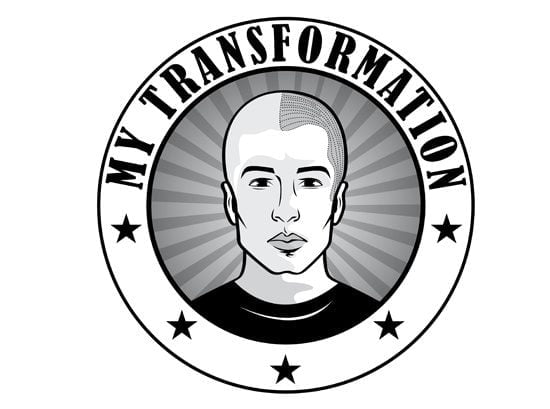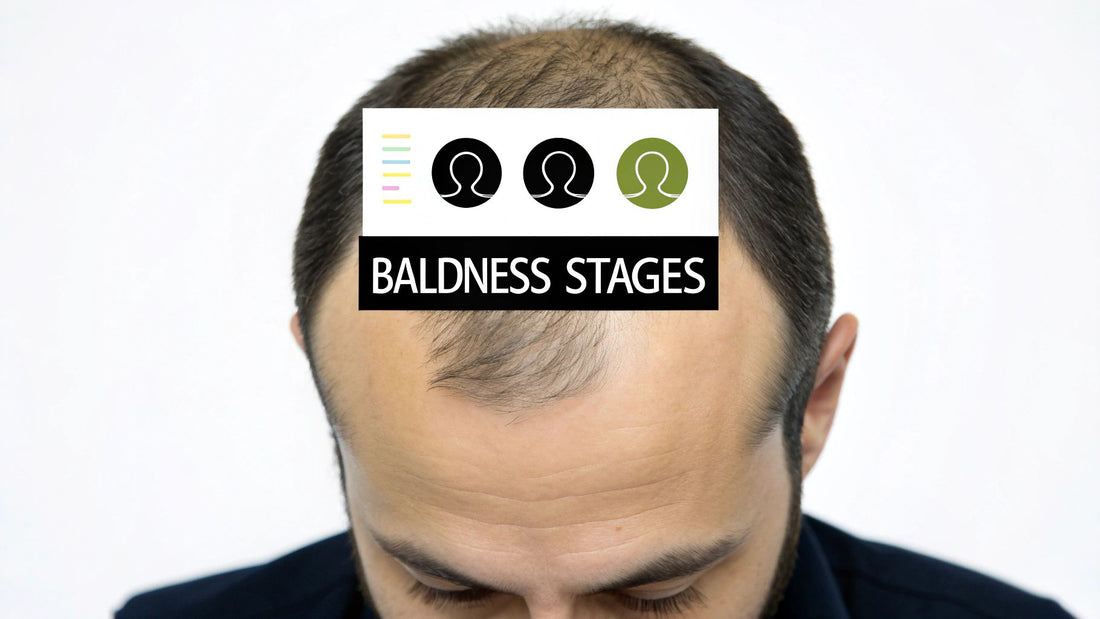
Your Guide to Male Pattern Baldness Stages
Share
Losing your hair can feel like a random, unpredictable process, but for most blokes, it follows a surprisingly clear path. This journey is mapped out by something called the Norwood Scale, which charts the typical progression of male pattern baldness. Knowing where you are on that map is the single most important step you can take towards getting back in control.
Understanding Your Hair Loss Journey
If you're noticing your hair thinning, you're in good company. Millions of men are on this same path. This guide is here to act as your field manual, breaking down the stages of androgenetic alopecia—the technical name for male pattern baldness. We're not looking for an overnight fix, but a clear understanding of a manageable process with some seriously effective modern solutions.
At its heart, male pattern baldness is a story about your genes and your hormones working together. This duo is what triggers the gradual shrinking of hair follicles. It's incredibly common, affecting about 50% of Australian men by the time they hit 50, and that figure jumps to a staggering 80% by age 70. The classic signs usually begin with a receding hairline at the temples and some thinning at the crown, all following the stages of the Norwood scale. You can dig deeper into the hair loss statistics for Australian men to see just how widespread it is.
What This Guide Will Do for You
Our goal here is simple: to give you the knowledge you need to make smart decisions. When you understand the science and can pinpoint your stage of hair loss, you can look at your options with real confidence. We’ll walk you through what's happening up top, and why it's happening, in a straightforward way.
This guide will help you:
- Pinpoint your current stage on the Norwood Scale using pictures and simple descriptions.
- Get a handle on the biological reasons for hair loss, without the confusing jargon.
- Discover effective solutions that actually make sense for each stage of the process.
- Learn about Scalp Micropigmentation (SMP), a brilliant option for creating the look of a full, natural hairline.
Think of it this way: figuring out your hair loss stage is like finding the "you are here" dot on a shopping centre map. Once you know exactly where you are, you can decide the best way to get where you want to go.
That feeling of seeing more hair on your brush or in the shower drain can be a real knock to your confidence. But realising this is a well-understood process can change everything. It shifts the focus from worry to action. You're not just a passive observer; you're witnessing a biological sequence that has been mapped out.
Let's move past the anxiety and get practical. We’re about to break down all seven stages of male pattern baldness in detail, so you can see exactly where you fit in. Once you're armed with that knowledge, we’ll introduce powerful solutions like Scalp Micropigmentation (SMP), which delivers immediate, game-changing results by replicating the appearance of a freshly shaved head of hair. This is your starting point. Let’s get to it.
Decoding The 7 Male Pattern Baldness Stages
Figuring out the stages of male pattern baldness is a bit like learning to read a map of your own scalp. The official map, used by experts everywhere, is called the Norwood Scale. It's the go-to system for classifying how hair loss progresses. Once you know where you are on that map, you can get a much better idea of the road ahead and choose the right path for treatment.
Think of your hairline like a shoreline. In the early days, the tide is just starting to go out, revealing a bit more sand at the temples. Fast forward to the later stages, and the tide is fully out, completely changing the landscape. Let’s walk through each stage so you can see exactly where you fit in.
This image gives you a great visual cue for what to look out for, helping you spot the very first signs of hair loss before they become more obvious.
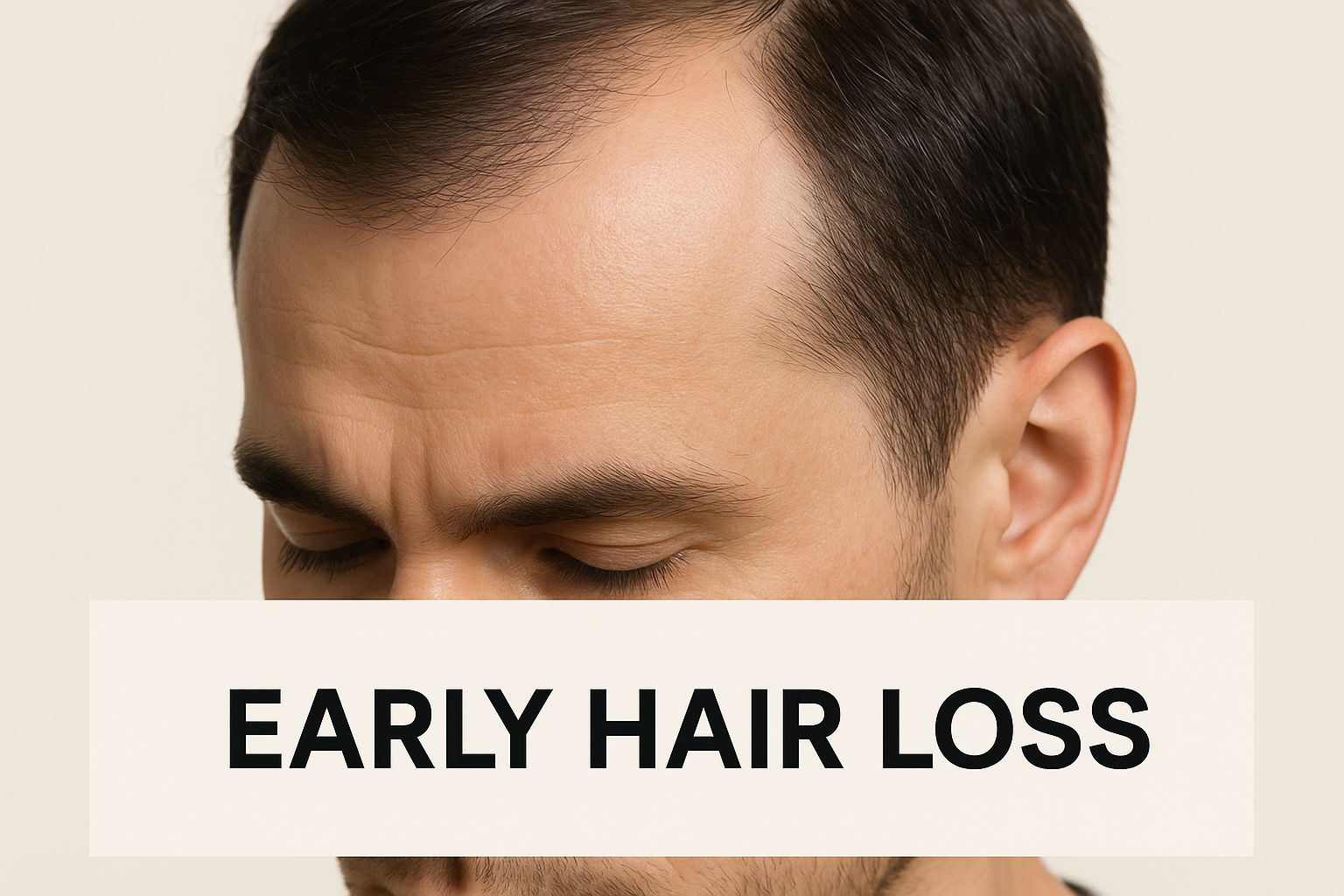
As you can see, the subtle but critical changes often start right at the temples, which is the classic first clue that male pattern baldness is kicking in.
Stage 1: The Baseline
Stage 1 isn't really "hair loss" at all—it's the starting point. This is your youthful, adolescent hairline, usually running straight across your forehead without any noticeable recession.
At this point, there are absolutely no signs of male pattern baldness. It’s a full head of hair, before the genetic and hormonal triggers have started to make their move. If you're here, the name of the game is prevention and just keeping an eye on things.
Stage 2: The First Subtle Shift
This is where the journey really begins for most guys. Stage 2 is marked by a slight, often symmetrical recession of the hairline, typically at the temples. It’s a minor change that starts to create a more mature, slightly M-shaped hairline.
Honestly, many men don't even realise they've hit Stage 2. The change is so gradual that it's easy to write it off as just your "adult" hairline settling in. But make no mistake, this is the first visible signal that male pattern baldness has been switched on.
Key Takeaway: Stage 2 is the golden hour. Acting now with preventative measures can make a huge difference in preserving the hair you have for years to come.
Stage 3: The First Clinically Significant Stage
By the time you reach Stage 3, hair loss is becoming much more obvious. That M-shape at the temples is now quite deep, and the recessed spots are either bare or only have very fine, weak hair left. This is the first stage officially classified as "baldness."
You might also see a variation of this stage:
- Stage 3: The classic, deep recession at the temples continues.
- Stage 3 Vertex: On top of the receding hairline, a small but distinct bald spot starts to form on the crown (the vertex).
This is a turning point. The hair loss is clear enough for others to notice, and it's often when men start seriously looking for solutions, from topical treatments to cosmetic options like Scalp Micropigmentation (SMP).
Stage 4: A Clear Progression
At Stage 4, the hair loss has become more severe. The recession at the temples is deep and pronounced, and the bald spot on the crown has grown larger.
The defining feature of Stage 4 is the strip of hair that still separates the two balding zones. A solid, though often thinning, band of hair still runs across the top of your head, connecting the hair on either side. The "bridge" is still there, but it's weakening.
Now, the overall look is one of definite thinning. It’s getting tougher to hide the hair loss with styling tricks, which pushes many to consider more permanent and reliable solutions.
Stage 5: The Bridge Begins To Weaken
Once you're in Stage 5, that band of hair separating the front and the crown is really starting to give way. It's noticeably thinner and narrower, and the two large areas of hair loss are on the brink of meeting.
The classic "horseshoe" pattern is starting to take shape, with most of the remaining hair concentrated at the sides and back of the head. The appearance is one of significant baldness.
To get a better handle on how these stages are officially categorised, you can learn more about the Norwood Scale in our detailed article. It gives a full breakdown of this essential tool.
Stage 6: The Final Merger
By Stage 6, the bridge is gone. The balding areas at the front and the crown have now completely merged into one large, single patch of hair loss.
The only significant hair left is on the sides and back of the scalp, forming a very distinct horseshoe pattern. While the hair on the sides might still be dense, the top of the scalp is almost entirely bare. At this point, medical treatments are unlikely to bring back much, if any, hair.
This is where cosmetic solutions truly come into their own. Scalp Micropigmentation can perfectly replicate the look of a full, sharp buzz-cut, restoring your hairline and framing your face in a way that looks completely natural.
Stage 7: The Most Advanced Stage
Stage 7 is the final destination on the Norwood Scale. All that remains is a thin, wreath-like band of hair that wraps around the back and sides of the head.
Even this remaining hair is often fine and may have thinned out considerably. The entire top of the scalp is completely exposed. This represents the full genetic expression of male pattern baldness.
But even at this most advanced stage, there are fantastic options. SMP can create a seamless and natural-looking buzz-cut style across the entire scalp. It's a timeless, masculine look that offers a definitive, maintenance-free solution and a major boost of confidence, no matter the stage.
To help you quickly identify where you might be, here's a simple breakdown of the Norwood Scale's visual cues.
The Norwood Scale At A Glance
| Stage | Primary Visual Signs | Common Age of Onset (Approximate) |
|---|---|---|
| Stage 1 | No visible hair loss; youthful, straight hairline. | Teens to Early 20s |
| Stage 2 | Slight recession at the temples; a mature or M-shaped hairline begins. | Early to Late 20s |
| Stage 3 | Significant recession at the temples; a bald spot may appear on the crown (Vertex). | Late 20s to 30s |
| Stage 4 | Deep frontal recession and a larger crown spot, separated by a band of hair. | 30s to 40s |
| Stage 5 | The separating band of hair becomes much thinner and starts to break down. | 30s to 40s |
| Stage 6 | The frontal and crown balding areas merge; only a horseshoe pattern of hair remains. | 40s to 50s+ |
| Stage 7 | Only a thin wreath of hair remains around the back and sides of the scalp. | 40s to 60s+ |
This table provides a quick reference, but remember that the age of onset can vary dramatically from person to person based on genetics.
The Science Behind Why Hair Loss Happens
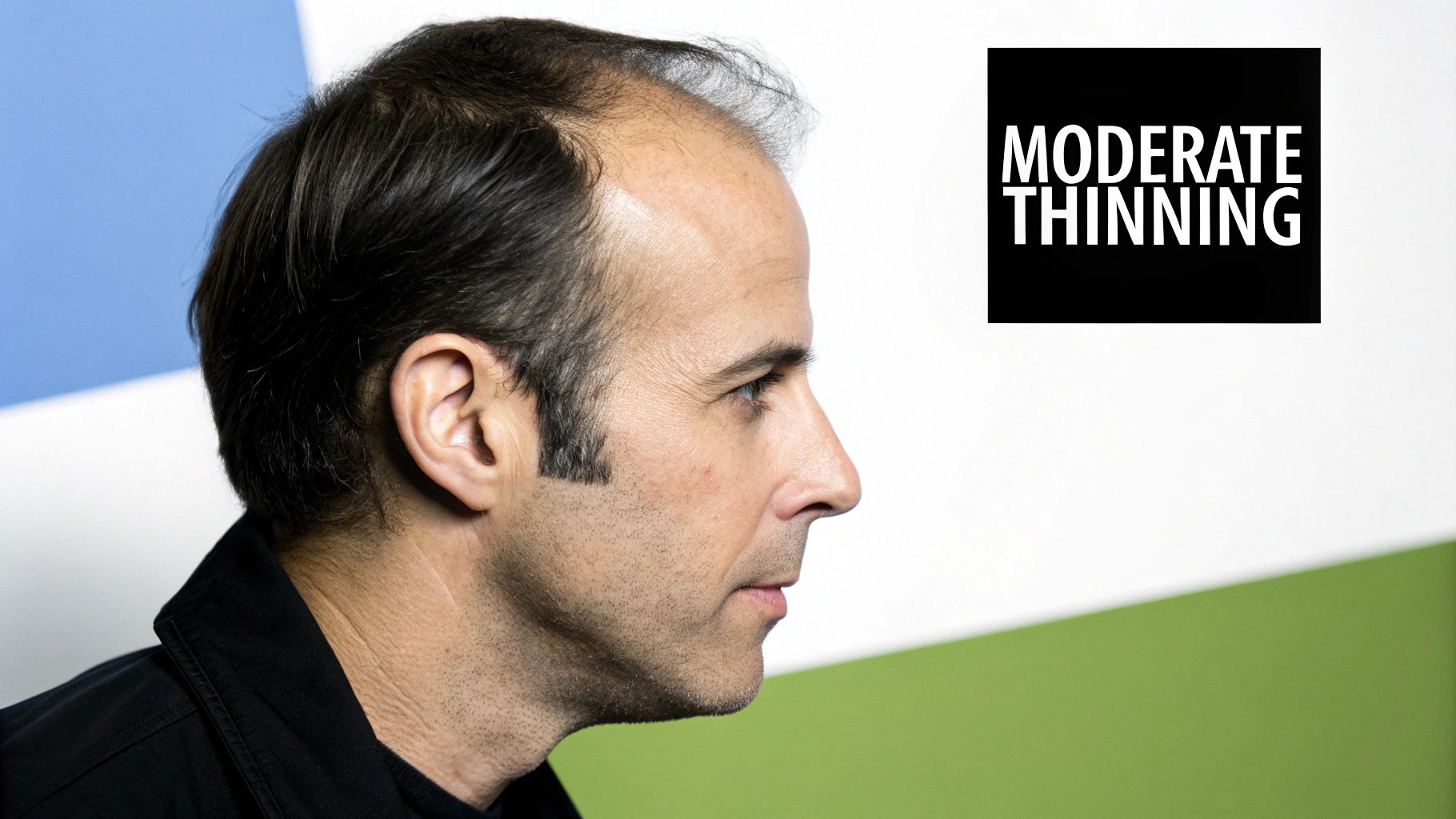
Watching your hairline start to change can be a real knock to your confidence, but getting to the bottom of why it's happening is the first real step toward finding a solution. Forget the old wives' tales about wearing hats too often or using the wrong shampoo. Male pattern baldness, known clinically as androgenetic alopecia, is a biological process dictated by two main players: your genes and a particular hormone.
It helps to think of your DNA as a set of inherited instructions. For many men, those instructions include a specific sensitivity in the hair follicles around the temples and crown.
The trigger for this sensitivity is a hormone called Dihydrotestosterone (DHT). It's a powerful derivative of testosterone, and if you've got that genetic predisposition, DHT is what sets the stages of male pattern baldness in motion.
The Role of DHT and Miniaturisation
When DHT latches onto these sensitive hair follicles, it begins to shrink them. This process is called miniaturisation, and it's a gradual takeover. Imagine slowly kinking a garden hose – the powerful gush of water weakens to a trickle, and eventually, it stops altogether. That's essentially what DHT does to your hair follicles.
Each hair on your head follows a natural growth cycle. Miniaturisation throws a spanner in the works by systematically shortening the 'growing' phase and extending the 'resting' phase.
With every new cycle, the hair that emerges from the follicle is thinner, weaker, and often lighter in colour than the one before it. Over time, the follicle shrinks so much that it can no longer produce any visible hair at all, leading to the familiar patterns of baldness. This is an incredibly common biological process, and you can get the full rundown on why men suffer from male pattern hair loss in our detailed guide.
The Key Takeaway: Male pattern baldness isn't about hair simply "falling out." It's a process of replacement, where healthy, thick hairs are gradually swapped for finer, weaker ones until they eventually vanish. The follicle is still there, just dormant.
This genetic trait is especially common here in Australia. In fact, statistics show that Aussie men are among the most affected by male pattern baldness in the world. The journey often starts early, with about 20% of men noticing some degree of hair loss in their 20s. This number climbs to roughly a third by their 30s and hits nearly half by the time they reach 40.
Do Other Factors Influence Hair Loss?
While genetics and DHT are the primary culprits, other lifestyle factors can sometimes play a supporting role in how quickly or severely you experience hair loss. It's crucial to understand these factors don't cause male pattern baldness, but they can pour a bit of fuel on a pre-existing fire.
If you're already genetically predisposed, these elements can sometimes affect your hair loss timeline:
- Significant Stress: A major physical or emotional event can trigger a temporary shedding phase called telogen effluvium. This won't cause balding on its own, but it can make an underlying condition look much more obvious.
- Poor Nutrition: A diet lacking in hair-healthy essentials like iron, zinc, and biotin can certainly impact hair quality. It won't kickstart genetic hair loss, but it can weaken the hair you have.
- Certain Medical Conditions: In some rare cases, underlying health issues can contribute to thinning hair. This is why it’s always a good idea to chat with a professional if you experience any sudden or unusual changes.
At the end of the day, though, the progression through the male pattern baldness stages almost always comes back to that inherited sensitivity to DHT.
Finding the Right Solution for Your Stage
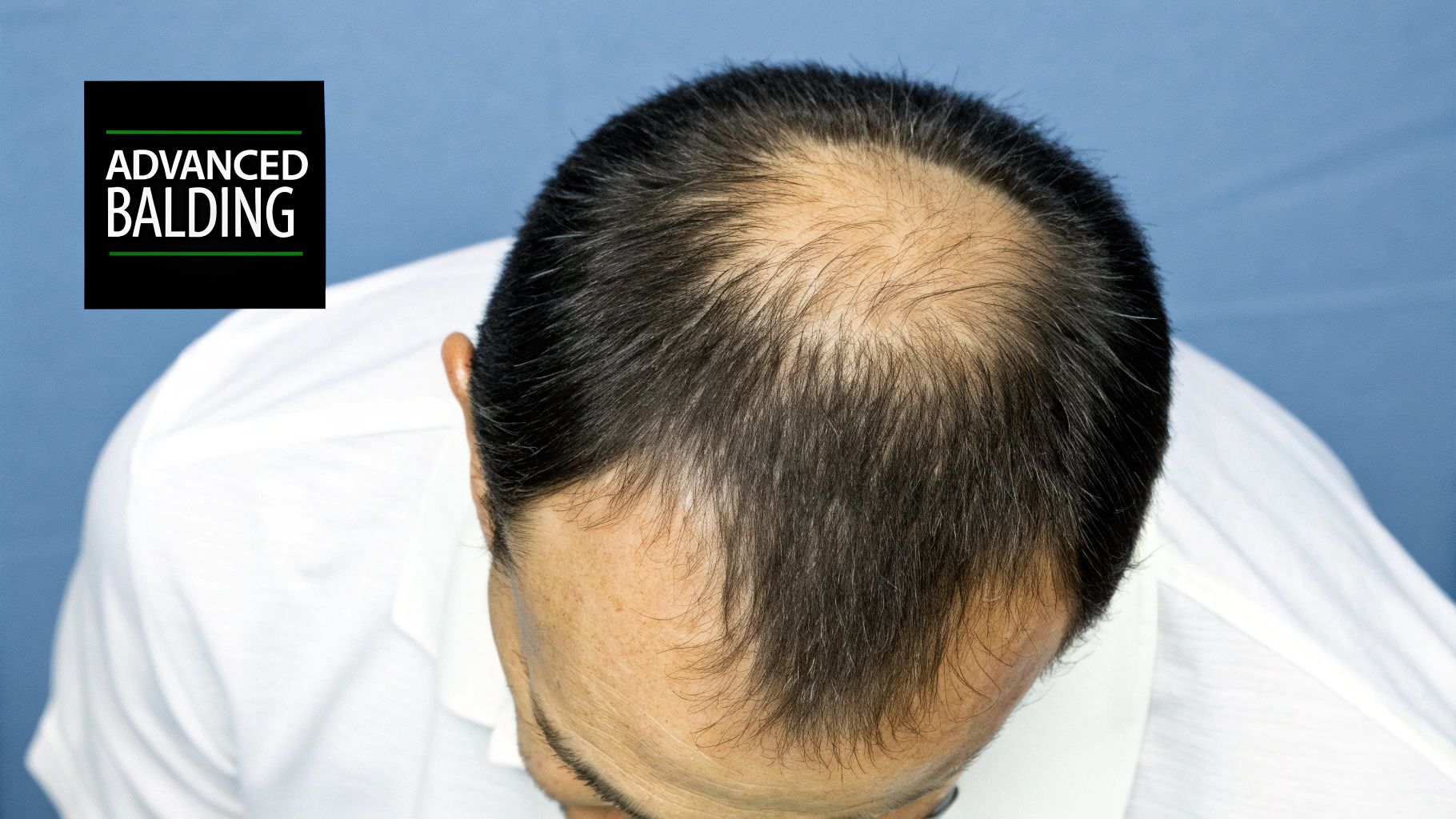
Knowing where you sit on the Norwood Scale is one thing, but figuring out what to do about it is the real game-changer. Once you pinpoint your stage, you can stop just watching the hair loss happen and start making informed decisions.
The best move for you depends entirely on where you are right now. A strategy that works wonders for a guy at Stage 2 just won't cut it for someone at Stage 6. Let’s walk through the most effective solutions for each phase so you have a clear roadmap.
H3: Tackling the Early Stages (Norwood 2-3)
When you’re just starting to notice thinning or a receding hairline, the main goal is preservation. You've still got plenty of hair, so the focus is on hitting the brakes on that miniaturisation process and keeping your existing follicles healthy and active. This is where medical treatments can make a huge difference.
Two of the most common and clinically-backed options are:
- Minoxidil: This is a topical foam or liquid you apply directly to your scalp. Think of it as a way to boost blood flow. It’s a vasodilator, meaning it widens the blood vessels around the follicles, feeding them more oxygen and nutrients to encourage growth.
- Finasteride: This is an oral medication that gets to the hormonal root of the problem. It works by blocking the enzyme that turns testosterone into DHT—the very hormone responsible for shrinking your hair follicles in the first place.
For many guys, these treatments are brilliant for slowing things down, but they're a long-term commitment. Stop using them, and you’ll likely lose any ground you’ve gained. On top of that, simple things like understanding why scalp massaging helps hair growth can also be a great addition to your routine.
H3: Mid-Stage Strategies (Norwood 4-5)
By the time you reach the middle stages, the strategy needs to evolve. While medications can still help you hang onto what you’ve got, you’re now dealing with more noticeable bald spots. The focus naturally shifts from pure prevention to active restoration.
This is where you start looking at ways to get back what you’ve lost. The goal is to either restore density to thinning areas or rebuild a hairline, creating a fuller, more complete look.
When prevention is no longer enough, cosmetic restoration becomes the focus. The aim is to reclaim the appearance of density and redefine the hairline in a way that looks entirely natural and intentional.
At this point, many men begin seriously considering more permanent solutions.
H3: Options for Advanced Stages (Norwood 6-7)
Once you’re in the advanced stages, the reality is that medical treatments won't bring back hair on the bald areas. The follicles on the top of your scalp have likely gone dormant for good, leaving the classic "horseshoe" pattern. Here, the conversation is all about cosmetic restoration.
You're essentially looking at two main paths:
- Hair Transplants: A surgical procedure where a surgeon moves healthy, DHT-resistant follicles from the back and sides of your head to the balding zones. It can deliver incredible, natural-looking results, but it’s only an option if you have enough healthy donor hair to work with.
- Scalp Micropigmentation (SMP): A non-surgical cosmetic tattoo that meticulously replicates the look of thousands of individual hair follicles. The final result is a perfect, clean-shaven buzz cut that blends seamlessly with any remaining hair.
For men with extensive hair loss, SMP is an incredibly powerful option because its success isn't tied to the amount of donor hair you have. It works for everyone.
H3: Why SMP is a Uniquely Versatile Solution
Scalp Micropigmentation is a standout because it’s not a one-size-fits-all fix. It’s a highly adaptable technique that can be tailored to help you at any stage of male pattern baldness.
Here's a quick look at how it can be applied across the Norwood Scale:
- For Early to Mid-Stages (2-5): SMP can be used to add the look of density. A skilled technician applies pigment between your existing hairs, which darkens the scalp and reduces the visible contrast. The result? Your hair looks instantly thicker and fuller.
- For Advanced Stages (6-7): This is where SMP truly shines. An artist can design and create a crisp, age-appropriate hairline that perfectly frames your face, giving you a sharp, modern buzz-cut look.
Many guys choose SMP because it offers immediate, reliable results with almost no ongoing maintenance. It’s a solution that ends the daily stress of dealing with hair loss. You can find out more about how https://www.mytransformation.com.au/blogs/news/scalp-micropigmentation-is-the-answer-to-hair-loss in our detailed guide.
Comparing Hair Loss Solutions
Choosing a path can feel overwhelming, so we've put together a simple table to compare the most common options and see where they fit best.
| Solution | How It Works | Best Suited For (Norwood Stages) | Expected Outcome |
|---|---|---|---|
| Minoxidil | Increases blood flow to follicles | 2-4 | Slows hair loss, potential for some regrowth |
| Finasteride | Blocks DHT production | 2-5 | Halts progression, preserves existing hair |
| Hair Transplant | Moves healthy follicles to bald areas | 3-6 (with good donor hair) | Permanent, natural-growing hair in treated areas |
| Scalp Micropigmentation (SMP) | Tattoos pigment to mimic follicles | 2-7 | Illusion of density or a full buzz cut |
Ultimately, the best solution is the one that aligns with your specific stage of hair loss, your lifestyle, and what you want to achieve. Whether you’re looking to preserve, restore, or redesign, there's a path forward.
A Closer Look at Scalp Micropigmentation
As you move through the different stages of male pattern baldness, your focus might shift from trying to slow down the loss to simply wanting to look and feel your best again. This is exactly where Scalp Micropigmentation (SMP) comes in. It’s become a go-to solution for a lot of guys because it offers a reliable and immediate cosmetic fix, no matter where you are on the Norwood scale.
So, what is it, really? Think of SMP less as a hair loss treatment and more as an incredible artistic illusion. It's a highly advanced form of cosmetic tattooing, where a trained specialist uses micro-fine needles to place tiny dots of pigment into the top layer of your scalp.
Each one of these dots is a perfect imitation of a single hair follicle. When you have thousands of them layered with expert precision, they create the undeniable look of a full head of hair that’s been freshly clipped to a sharp buzz cut. It’s like a form of pointillism for your scalp, crafting a completely natural-looking hairline.
The Real-World Benefits of SMP
Unlike medications you have to take forever or surgeries that hinge on how much donor hair you have, SMP delivers guaranteed results without the ongoing hassle. For many men, its simplicity and effectiveness are the biggest draws—it offers a permanent solution to the daily stress of trying to hide thinning patches.
Here’s what really sets it apart:
- Immediate Visual Impact: You'll see a noticeable difference right after your first session. The complete, polished look is usually locked in over just two to three appointments.
- Zero Downtime: There’s no real recovery to worry about. You can pretty much get back to your normal routine straight away, with only a few simple aftercare rules to follow.
- Seriously Low Maintenance: Forget about special shampoos, creams, or daily pills. Looking after your SMP is as easy as moisturising your scalp and using sunscreen to keep it looking sharp for years.
This isn't about chasing hair regrowth; it's about flawlessly recreating the look of it. SMP gives you back the frame to your face—a defined, natural hairline that restores your profile and, with it, your confidence.
Understanding the SMP Process
Getting a restored hairline with SMP is a pretty straightforward and collaborative journey. It all kicks off with a detailed consultation where you sit down with a technician to map out exactly what you want. You'll work together to design a hairline that not only looks natural for your age but also perfectly complements your facial structure.
From there, the process is broken down into a couple of sessions:
- The First Session: This is where the groundwork is laid. Your technician will establish the shape of your new hairline and apply an initial, lighter layer of pigment to create the foundation.
- Subsequent Sessions: In your next appointments, usually a week or two apart, it’s all about building density. The technician will add more layers, often with slightly darker pigment shades, to create a rich, 3D effect that’s indistinguishable from real hair follicles.
The single most important factor for a great result is finding a skilled and experienced technician. The real artistry is in blending the pigment with your remaining hair and creating a soft, subtle hairline that doesn't look harsh or fake. While the investment can vary, it's worth getting a clear picture of the factors that influence scalp micropigmentation cost before you commit. For most guys, it’s a one-off price for a permanent boost in confidence.
Answering Your Hair Loss Questions
Walking the path of hair loss can feel confusing, and it's only natural to have a heap of questions. Let's cut through the noise and get straight to the practical answers you need to feel confident about your next steps.
Can I Stop Male Pattern Baldness From Progressing?
This is the big one, isn't it? While you can't completely halt a genetic process in its tracks, you can absolutely slow it down and put up a solid fight. The key is to act early, ideally around Norwood stages 2 to 4.
Medical options like Finasteride work by tackling DHT, the hormone responsible for shrinking hair follicles. At the same time, Minoxidil can help stimulate blood flow and encourage new growth. But as you move into the later male pattern baldness stages, the game plan shifts from prevention to cosmetic restoration. This is where solutions like Scalp Micropigmentation (SMP) really shine, giving you the look of a full head of hair, no matter what your genes are up to.
At What Age Do The Baldness Stages Typically Start?
There's no magic number here. Your genetics are firmly in the driver's seat. Many blokes start to see the first signs in their late 20s or 30s, but for others, the journey can begin as early as their late teens.
Your best crystal ball is your family tree. Take a look at your father, grandfathers, and uncles. It's also worth remembering that your Norwood stage has nothing to do with your age. A man in his 50s could easily still be a Stage 3, while someone in his early 20s might already be at Stage 4.
Is SMP a Good Solution for All Baldness Stages?
Absolutely. One of the best things about Scalp Micropigmentation is its incredible versatility. It works brilliantly across the entire Norwood scale; we just adapt the technique to suit your specific level of hair loss.
- For Early to Mid-Stages (Norwood 2-5): SMP adds fantastic density. We apply pigment between your existing hairs, which makes thinning areas look much thicker and fuller.
- For Advanced Stages (Norwood 6-7): When most of the hair is gone, SMP excels at creating a sharp, clean, and realistic buzz-cut look that frames the face perfectly.
This makes SMP a fantastic option for men who aren't good candidates for a hair transplant or for anyone who simply wants a guaranteed result that looks great and is easy to maintain.
How Quickly Does Hair Loss Progress?
The speed can vary wildly from person to person. For some guys, it's a slow burn that unfolds over decades. For others, it can feel like it happens almost overnight, with rapid changes over just a few years. Things like major stress can sometimes hit the accelerator, as we explain in our guide on stress-related hair loss.
Australian research shows a clear clinical progression: follicles shrink and hair density decreases long before bald patches appear. By ages 40-55, around 31% of Australian men have noticeable vertex or full baldness. That number jumps to 53% for men aged 65-69, showing how the stages tend to advance over a lifetime. You can read more about the progression of male pattern baldness.
Will I Definitely Go Completely Bald?
Not necessarily. Your genetic blueprint dictates where your hair loss journey will ultimately end. Plenty of men find their hair loss stabilises at an earlier stage, like a Norwood 3 or 4, and it never gets any worse. Again, looking at the older men in your family can often give you a pretty good idea of what to expect.
At My Transformation, our focus is on helping you find the right solution for your unique situation. If you're ready to take back control and restore your confidence, see how Scalp Micropigmentation can work for you at https://www.mytransformation.com.au.
